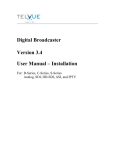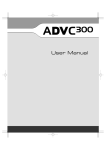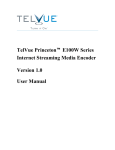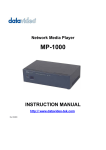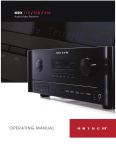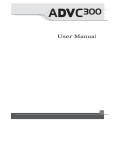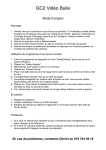Download PEG.TV Version 1.0 User Manual
Transcript
PEG.TV Version 1.0 User Manual Trademarks TelVue Corporation™ is a registered trademark. All other products, services, or company names mentioned herein are claimed as trademarks and trade names by their respective companies. © 2008 TelVue Corporation. All rights reserved. No portion of this manual may be copied by any means without the prior consent of TelVue Corporation, Inc. TelVue Corporation 16000 Horizon Way, Suite 500 Mt. Laurel, NJ 08054 USA 800.885.8886 (Phone) 856.866.7411 (Fax) http://www.telvue.com All specifications, notices and warnings are subject to change without notice. September 18, 2008 ii PEG.TV User Manual v. 1.0 Table of Contents Getting Started ................................................................................................ 1 Starting the PEG.TV User Interface...................................................................................1 Adding Content to the PEG.TV Host .............................................................................2 Importing Content to PEG.TV...........................................................................................3 Viewing and Editing Content ......................................................................... 5 Thumbnail View................................................................................................................5 Table View........................................................................................................................6 Show Content Page ...........................................................................................................7 Editing Content Information..............................................................................................8 Searching for Content........................................................................................................9 Quick Search .................................................................................................................9 Advanced Search ...........................................................................................................9 Working with Content .....................................................................................................10 Bulk Actions ................................................................................................................10 Playlists.......................................................................................................................11 Playlist Actions............................................................................................................12 How Viewers Watch PEG.TV Files.............................................................. 16 Using Third-Party Editing Software ............................................................ 18 Encoding Recommendations ...........................................................................................18 Using ProCoder to Produce FLV Files ........................................................ 19 Using Riva FLV Encoder to Produce FLV Files ......................................... 20 Using On2 Flix to Produce FLV Files .......................................................... 22 Using Sorenson Squeeze to Produce FLV Files ........................................... 24 Using Adobe Premiere to Produce FLV Files.............................................. 25 User Management ......................................................................................... 27 Version Information...................................................................................... 28 Technical Support ......................................................................................... 28 Glossary ......................................................................................................... 29 PEG.TV User Manual v. 1.0 iii September 18, 2008 Getting Started PEG.TV™ by TelVue Corporation is an Internet-based service designed for public, education, and government (PEG) stations. It provides your station with Video-on-Demand and video streaming service from your website to your viewers. PEG.TV lets your local viewers watch programs whenever they want, and out-of-town viewers watch programming they cannot see outside your broadcast area. Be sure to record your customer information. You will need your: • CMS Address: _ http://origin.peg.tv:3000______________________________ • Username: ________________________________________________________ • Password: _________________________________________________________ • FTP Address: ______________________________________________________ • Web Host Address: _________________________________________________ Starting the PEG.TV User Interface 1. Go to http://origin.peg.tv in your web browser. This will take you to the PEG.TV sign-in page. 2. Enter your username and password and click the Login button. The Content tab is displayed. PEG.TV User Manual v. 1.0 1 September 18, 2008 Adding Content to the PEG.TV Host Use FTP to load your FLV files onto the PEG.TV host. FTP is a file-transfer protocol that lets you upload files from one network to another. While this can be convenient, you must consider your installation’s firewall. Consult your IT department before proceeding. You will need an FTP client application that supports drag-and-drop transfers. Some Web browsers support an integrated FTP client. Be aware of your FTP client’s limitations, especially older ones. For example, the one in Internet Explorer v. 6 limits filesize to 3.9GB. TelVue recommends the freeware FileZilla FTP program found at http://filezilla-project.org/. Setting FTP Mode to Active FTP must be set to active mode for file sharing to work. The default FTP setting in most browsers is passive mode. Passive mode opens too many ports. To set FTP Mode to active in Internet Explorer: 1. Click on Tools Internet Options to open the Internet Options window. 2. Click on the Advanced tab. 3. In the Browsing section, scroll down to Use Passive FTP (for firewall and DSL modem compatibility) and click in the box to uncheck it. 4. Click OK to save the setting and exit. To set FTP Mode to active in FileZilla: 1. Click on Edit Settings to open the Settings window. 2. Click on Connections Firewall Settings. 3. Uncheck the Passive Mode button to make the FTP mode active. 4. Click OK to save the setting and exit. Running FTP Once you have an FTP client application and your settings are in place: 1. Open your ftp client and type ftp://origin.peg.tv in the browser address window. 2. Enter the username and password you received from TelVue. This will take you directly into your installation’s upload folder (directory). 3. Use FTP to download files to your PEG.TVhost folder. Once the content is in your host folder you will use PEG.TV’s Import function to make the content available for streaming. September 18, 2008 2 PEG.TV User Manual v. 1.0 Importing Content to PEG.TV Once the content has been uploaded to the PEG.TV file system, use the Import Content function to add it to PEG.TV for management. To begin, go to the Content tab and click on the Import Content menu. Import One File To import one content file at a time, choose the file from the drop-down list and click the Import button. The Import Log is displayed, stating whether or not the import was successful. The application also displays the thumbnail or full row for the imported file. To import more files, select another filename from the drop-down list and click Import again. Import with Metadata To import a content file and input its metadata at the same time: 1. Click on Import with Metadata on the left side of the Content page. 2. Select a filename from the drop-down list. 3. Fill in the metadata. PEG.TV User Manual v. 1.0 3 September 18, 2008 • Program Guide Information o Program Code – Enter codes used at your installation, if applicable. o Program – the name of the program as it would be displayed on the PEG.TV Player’s content list. o Episode Code – Enter codes used at your installation, if applicable. o Episode – If the file is part of a series and each episode has a name, it is displayed here as it would be on the PEG.TV Player’s content list. o Description – Type a detailed description of the content. • Expiration o If you want to remove the content from PEG.TV at a specific date and time, enter them in the boxes. Otherwise the content will remain on the server until you schedule a deletion. For example, when importing winter-themed content you might schedule its deletion for the first day of spring. • Categories o Select one or more event categories from the list. Click on Import Content at the bottom of the window. The application displays the Import Log and tells whether the content imported successfully. To import more content with metadata, click on Back. To return to the Content screen, click on Content at the top of the Content Import With Metadata screen or click on the Content tab. To edit file information, click the [Edit] link. To locate recently imported content that might need updates to its metadata, choose the Advanced Search feature and filter for recently added content, such as Last 5 Minutes. September 18, 2008 4 PEG.TV User Manual v. 1.0 Viewing and Editing Content The Content page shows available content and manages content on the PEG.TV server. Use this page to see what content is currently available, to search for specific content, to import new content files, and to perform bulk actions on selected content such as deleting or categorizing. Two views are available; the default thumbnail view and the table view. The top of the page shows how many titles appear on this page. To see more titles, use the drop-down list to select a larger display size. You may display up to 100 titles per page. The other drop-down box lets you switch between Thumbnail View and Table View. The Select All checkbox on the right lets you check all titles displayed on the page (not necessarily all titles on the system) for bulk action. Note: To select all content on a page (up to 100 titles), first choose Show 100 per page from the drop-down box. Clear all advanced searches so all titles are displayed. Then click the Select All checkbox. PEG.TV comes with sample Flash Video clips. To make other files available for your community, use the Import Content function to import them. Thumbnail View Each thumbnail displays a scene from the content with the following information. • Checkbox – allows you to select the content for a bulk action, such as a purge or deletion. • Filename – the name of the content as it is stored on the server, typically the filename without the extension. If the name is long, mouse over it to display the full name. Clicking on the name takes you to the Show Content page. PEG.TV User Manual v. 1.0 5 September 18, 2008 • Running Time – the playing time of this file, after any virtual trimming, in hours, minutes, and seconds (HH:MM:SS). • Program or Program Code – the program name or program code of this file,. If the name is too long, mouse over the ellipsis (. . .) to see the full name. • Episode or Episode Code – the episode name or episode code of this file, if applicable. If the name is too long, mouse over the ellipsis (. . .) to see the full name. • Edit – Link to the edit page so you can edit the file information and optional metadata for this content. Table View Table View displays the content as a list without any thumbnail images. As in Thumbnail View, you may show 10, 20, 50, or 100 titles per page. To go to one of the other pages, click on the page number links or the <Previous or > Next links in the lower-right corner. • Select Checkbox – allows you to mark the content for bulk actions by checking the box. • Filename – the filename of the content. The last portion of the filename usually indicates the file type, such as MPG or JPG. • Program – The name of the program. • Episode – The episode name of this file, if applicable. • Size – the size of the file, typically in megabytes (MB) or gigabytes (GB). • Duration – the runtime of this file in hours, minutes, and seconds (HH:MM:SS) including any virtual trimming. September 18, 2008 6 PEG.TV User Manual v. 1.0 • Play Count – the number of times this file has been played since the system was installed. • Create/Ingest Date & Time – the date, time, and day of the week the content file was captured or imported onto the server. (T = Tuesday, Th = Thursday) • Delete At – if this file is scheduled for deletion from the system, this field shows the date and time the deletion will take place. • Type – the type of content in this file, usually a video or audio file. • Action – you can edit the file information and optional metadata for this content. Show Content Page When you click on a filename or thumbnail on the Content page, the Show Content page is displayed. This page shows the content’s properties. The fields displayed for the file are described briefly below. • General – information about the file similar to what is displayed on the Content page, such as filename, type, runtime, status, owner, size, creation date, and delete date. To change this information, click the Edit button at the right. • Categories – any programming categories in which this file appears, as selected by the operator. To put this file in a category, click the Edit button at the right. To set up categories, use the Content Management section of the Config page. • File Properties – the encoded video and audio properties of the file, including format, bitrate, and type. The file properties cannot be edited. File actions for this content file are shown in the upper right of the page, below the thumbnail frame. Not all actions are available for all content. • Edit – to change the file information for the content, click the Edit button. This takes you to the Edit Content page as described in Content File Actions. PEG.TV User Manual v. 1.0 7 September 18, 2008 • Delete – to delete the content from the PEG.TV server file system, click the Delete button. This action is described more fully in Content File Actions. • Note: Use caution when deleting content, since this permanently removes the file from the file system. Purge – to remove the content from the PEG.TV list, but preserve it on the server’s file system, click the Purge button. This action is described more fully in Content File Actions. To return to the Content page from the Show Content page, click on the Content tab at the top of the screen. Editing Content Information To change the file information for a content file, such as its description, the program name to display with the thumbnail, or a deletion date, click on the file’s Edit action. The Edit Content page is displayed. The Edit Content page displays information about the content including its media type and format, and encoding information. The following information can be edited. September 18, 2008 8 PEG.TV User Manual v. 1.0 • Program – Enter the name of the program as it should appear on the Flash player. If you leave this field blank, the player will display the filename. • Episode – Enter the name of the episode as it should appear on the Flash player, if applicable. • Summary – Enter any information you want displayed below the content title on the PEG.TV Player content list. • Description – (optional) Enter a detailed description of the content as well as any keywords to be used to search for this content. • Related Link – If you want your viewers to have the option of linking to something related to this content, insert the link here. It will display on your PEG.TV page with a small arrow. • Delete At – To set a date and time for the content file to be automatically deleted from the server, type a date in the form MM-DD-YYYY or click on the Calendar icon or Today icon to choose a date. If no time is specified, then the content is deleted at midnight the next day. To keep the content on the server indefinitely, leave the date and time blank. When you have finished editing the content file information, click the Save button. The application saves the changes and returns you to the Content page. To return to the Content page without changing anything about the content, click the Cancel button. Note: This information becomes part of the content’s metadata and will always be associated with this content unless and until you change it. Searching for Content Use the search features to locate the content you want to work with so you can categorize it, create playlists, or delete outdated content. Quick Search To search for content on the main Content page by keyword, type a keyword or phrase in the Quick Search box and press Search. The server will display all available content that matches the search. The keyword may appear as typed in the file name, program, episode name, program or episode code, description, or other content metadata. Advanced Search To search for content using specific criteria, such as category or a media type, press the Advanced Search tab. Fill in one or more of the boxes. • Category – Select one of the categories used on your PEG.TV server, such as Community or Sports. • Program – Enter the exact program title. If you are not certain of the program title, use the Keywords field. PEG.TV User Manual v. 1.0 9 September 18, 2008 • Added – Select the time period that best describes when this content was added to your server. Time periods range from 5 minutes ago to 7 days ago. If the content was added more than 7 days ago, select Anytime. • Min Duration – Enter the minimum duration of the content in hours, minutes, and seconds as it would appear in the content metadata. • Max Duration – Enter the maximum duration of the content in hours, minutes, and seconds as it would appear in the content metadata. • Keywords – Type any keywords that might help identify this content. Keywords can match most metadata including the filename and file path. Press Search. PEG.TV displays the content that matches your search terms. If all results of the search are not displayed, select a larger display number (up to 100) from the drop-down list at the top of the page. If you don’t see the content you wanted, adjust the selections in one or more categories or press Clear to start again. To see all titles again, press Clear, then press Search. Working with Content Once you have displayed the content thumbnails or list, you can categorize it, create playlists, delete outdated content, or import more content. Bulk Actions To take action – such as delete or purge – on one or more content files, use the checkboxes to select one or more files – or use the Select All checkbox to select all content on the current page (not necessarily all titles on the system) – and click on the Bulk Actions tab on the left side bar of the page. Choose one of the following actions from the drop-down list. • • Note: If you used the Search features and want to take bulk action on all search results, use the drop-down list at the top of the page to display all the results (up to 100 titles). This will help prevent you from performing a bulk action on only some of the titles you want. Purge from Library – Purging files removes them from the PEG.TV content list, but keeps them on the server and in the database. To purge files, select them and click the Purge button. The application asks for confirmation. If you are sure you want to purge these titles, click on Yes (OK). The application removes the selected files from the list and unlocks the file on the file system that it can be edited, written, and deleted. Otherwise click on No (Cancel), and the application leaves the content list unchanged. Delete from Library and Filesystem – Deleting files September 18, 2008 10 PEG.TV User Manual v. 1.0 removes them from the content database and the server. Use this option to remove outdated content from the server. To delete files, select them and click the Delete button. The application asks for confirmation. If you are sure you want to delete these titles from the PEG.TV database and the server, click on Yes (OK). The application removes the selected files from the list. Otherwise click on No (Cancel), and the application leaves the content list unchanged. • Add to Category – Select a category from the drop-down list and click the Add button. The application confirms that the selected titles have been added to the category. • Remove from Category – Select a category from the drop-down list and click the Remove button. The application confirms that the selected titles have been removed from the category. Playlists A playlist is a category of files displayed on your PEG.TV website. You can create playlists of meetings, community events, ball games, etc. Create Playlist To create a playlist, click the Create Playlist button under the Playlists tab on the Content page. A blank Playlist Metadata screen is displayed. Fill in the playlist metadata fields as needed. Descriptions o Name – the name of the playlist. o Description – A brief description of the playlist, such as the type of files it contains. Published o Published? If the playlist is to be published on the webpage, check this box. up to 10 playlists may be published. PEG.TV User Manual v. 1.0 11 September 18, 2008 When you have finished entering the playlist metadata, click the Save button. You now see the Manage Playlist Items screen. See My Playlists: Manage Items for instructions. Order Playlists To set the order in which categories are displayed on the PEG.TV website, click the Order Playlists button under the Playlists tab on the Content page. The playlists are displayed. Mouse over a playlist bar and click on it to grab it. Drag the playlist bar to a new position in the list of playlists and release it. The playlists are reordered. Playlist Actions The next two sections under Playlists let you manage playlists and their content. The difference between “My Playlists” and “All Playlists” is that you can edit, manage, append content to, and delete your playlists in the “My Playlists” list that are owned by you, but you can only view and copy playlists in the “All Playlists” list that are owned by other users. Administrators can view and manage all playlists, but other users cannot view private playlists other than their own and can manage only their own playlists. September 18, 2008 12 PEG.TV User Manual v. 1.0 My Playlists: Edit Metadata To edit the metadata in a playlist, select the playlist from the drop-down list and click the Edit Metadata button. Change the playlist metadata and click the Save button. Once you have saved the metadata changes, you can also add or delete items from the playlist by clicking Manage Playlist Items next to the Save button. My Playlists: Manage Items To add, delete, or re-order items from a playlist, select the playlist from the drop-down list and click the Manage Items button. The Manage Playlist Items screen is displayed. Use the Search feature to find the FLV files you want in your playlist so they are displayed on the left. Drag and drop image icons from the Search Results column on the left of the screen to the playlist area. To change the order of items in the playlist, drag the item’s icon to the place where you want it or change its number in the box to the right of the icon. To delete an item from the playlist, click its trash icon . When you have finished, click the Save Changes button. Click on Content to return to the Content page. Important: Your playlist changes will only be saved if you click the Save Changes button after making changes. My Playlists: Manage Items: Enter Item Edit Mode Item Edit Mode is another way to see content detail for the items (files) in the playlist. To see items, click on Enter Item Edit Mode at the top of the Manage Playlist Items window. PEG.TV User Manual v. 1.0 13 September 18, 2008 The list of items in the playlist is displayed. The top of the table shows how many items are in the playlist and the duration of the entire playlist. To see more information for a playlist item, click on its Edit icon The Edit Playlist Item screen is displayed. in the Action column. When you have finished, click Save or Cancel. When you have finished looking at items in the playlist, click Exit Edit Item Mode in the upper right corner to return to the Manage Playlist Items screen. My Playlists: Append Content To add content to the end of a playlist from the main Content page, check one or more thumbnails to select them. September 18, 2008 14 PEG.TV User Manual v. 1.0 Select the playlist from the drop-down list. In this example the thumbnail for Autism_004 has been checked. Click the Append Content button. The system asks you confirm; click OK to append the content. The new items are added to the end of the playlist and a confirmation message is displayed at the top of the page. My Playlists: Delete Playlist To delete a playlist, select it from the My Playlists drop-down list and click the Delete Playlist button. The system asks you confirm; click OK to delete the playlist. PEG.TV User Manual v. 1.0 15 September 18, 2008 How Viewers Watch PEG.TV Files To watch Flash videos over the Internet, your viewers must have: • Internet access – Broadband access is desirable. Viewers with a phone-line modem will experience delays while the file is loaded. • Web browser – Internet Explorer and Firefox are recommended, but others may work. To watch videos, instruct your viewers to go to your hosted site. 1. Navigate to the PEG.TV site supplied to you, such as http://origin.peg.tv:3000/pegtv_player?affiliate=affiliate01. A player screen such as the one in the illustration is displayed. 2. The bar at the upper right of the window shows how many video clips are available in this category. To see more categories, click in the bar. September 18, 2008 16 PEG.TV User Manual v. 1.0 3. Click on the name of the file you want to play. A white bar below the video shows how much of the file you have played. The counter at the left shows how much of the file has played so far in hours, minutes, and seconds (HH:MM:SS). The counter at the right shows how long the file is. 4. While the file is playing you can: o Pause. o Start from the beginning. o Go to the end. o Click on the white slider to move forward or backward in the file. o Enlarge the video to full screen size. Click on the icon again to return to the player. o Adjust the volume. PEG.TV User Manual v. 1.0 17 September 18, 2008 Using Third-Party Editing Software This section contains guidelines for using selected software to save content as Flash Video (FLV) if your content does not arrive in flv format. Look on the TelVue support portal for guidelines on using additional video editing software packages. Note: TelVue’s recommendations regarding the use of third-party software packages are subject to change without notice. Encoding Recommendations TelVue recommends you follow these criteria when encoding the FLV files. However, the criteria you need to encode Flash files for use at your installation may vary, depending on the software used to edit files, the speed at which your typical viewers can stream files, and what quality your viewers expect. Refer to the encoder and editing software documentation for their requirements. TelVue strongly recommends you review these encoding requirements and recommendations, as well as the requirements for your encoder and editing software, to determine what encoding criteria will work best for your installation. Encode and test a few files before committing resources to a large effort. • Video Recommendations o Video codec: On2 VP6 o Frame width: 320 pixels o Frame height: 240 pixels o Framerate: 29.97 o Key frame every 30 frames o Bitrate: 256 kbps o Deinterlaced or non-interlaced video • Audio Recommendations o Audio codec: MPEG Layer III (MP3) o Sampling rate: 22050 Hz o Output: Mono o Bitrate: 32 kbps September 18, 2008 18 PEG.TV User Manual v. 1.0 Using ProCoder to Produce FLV Files Use these settings with ProCoder versions 2.0 and 3.0 to encode Flash (FLV) files for use with PEG.TV. 1. Select the Target tab and click Add. 2. In the Target List box, click QuickTime Exporter to display the export screen. 3. Click on Modify Exporter Settings and set the parameters in the Target box. Destination section o Path – enter the pathname of your media folder, typically C:\Documents and Settings\psguser\My Documents. o File Name – enter the filename, such as C:\Documents and Settings\psguser\My Documents\Planning_Board_May. o Select Exporter – select Macromedia Flash Video (FLV) from the dropdown list. Video - Basic section o Width – should be 320 (the default) o Height – should be 240 (the default) o Frame Rate (fps) – enter 15 o Interlacing – should be non-interlaced (the default) o Aspect Ratio – choose Video 4:3 Pixel 1:1 (the default) from the drop-down list. Audio - Basic section – keep the default settings. 4. Click Save Profile. PEG.TV User Manual v. 1.0 19 September 18, 2008 Using Riva FLV Encoder to Produce FLV Files Use these settings with Riva FLV Encoder version 2.0 to encode Flash (FLV) files for use with PEG.TV. Riva FLV Encoder transcodes AVI, MPEG, Quicktime, and WMV formats. 1. In the Input section, enter or browse for the source file you want to encode, such as C:\CAPTURE\DrunkDrivingPSA.avi. 2. In the Output section: o Click the Video tab and enter the name of the directory (folder) where you want to save the FLV file. You might want to use your PEGTV import folder. o Enter the output filename with the FLV extension, such as DrunkDrivingPSA.flv. 3. In the Preset section, choose PegTV.xml from the drop-down list. 4. In the Video section, use these settings: o Movie Size – choose 320x240 o Deinterlace – check the Deinterlace box o Framerate – choose 15 September 18, 2008 20 PEG.TV User Manual v. 1.0 o Bitrate – choose 300 o Start Offset – enter 0 unless you don’t want the first few seconds of your source file. o Duration – leave blank to transcode the entire file o Show Padding/Crop – check the box and leave the others blank 5. In the Audio section, use these settings: o Enable Audio – check the box o Bitrate – choose 56 o Sampling rate – choose 22050 o Stereo/Mono – check the Mono box 6. Click the Encode button to begin encoding the file. PEG.TV User Manual v. 1.0 21 September 18, 2008 Using On2 Flix to Produce FLV Files The standard, desktop version of Flix can transcode the major video formats. Use these settings with On2 Flix Standard to encode Flash (FLV) files for use with PEG.TV. 1. Click on the File tab. 2. In the File Information section: o Input – Browse for, or enter the name of, the input file, such as C:\CAPTURE\DrunkDrivingPSA.avi. o Output – Enter the output filename with the FLV extension, such as DrunkDrivingPSA.flv. o Preset – Choose the 300K Broadband Video (MX FLV) preset. 3. In the Export Options section, keep the VPGE FLV default and make sure the Export Video and Export Audio boxes are checked. 4. Click on the Vid/Aud tab to display the video and audio settings. September 18, 2008 22 PEG.TV User Manual v. 1.0 5. In the Video Dimensions section: o Check the No Constraints box. o Set the width to 320 and the height to 240. 6. In the Framerate Settings section, uncheck the Use source framerate box and enter a video framerate of 15.000. 7. In the Video Encoder Settings box: o Choose a Rate Control Mode of CBR (streaming). o Check the Maximum bitrate box and choose 300 kbps. 8. In the Audio Output Settings section: o Select a sampling rate of 22050 Hz. o Select a bitrate of 40 kBits/sec. 9. In the Audio Codec section, check the MP3 box. 10. Return to the File tab and click the Encode button. PEG.TV User Manual v. 1.0 23 September 18, 2008 Using Sorenson Squeeze to Produce FLV Files Sorenson Squeeze can transcode the major video formats. Use these settings with Sorenson Squeeze version 5 to encode Flash (FLV) files for use with PEG.TV. 1. In the main window, click the Import File button or drag the input file into the window. 2. In the Audience Presets section, open Web → Streaming→ FLV (Flash 6+) and select the F6_256K preset. Click the Apply button. 3. In the Filter Presets section, select Auto Crop Deinterlace. 4. In the Publish Presets section, select Copy to Local Directory and use the directory (folder) where you store your PEGTV files. 5. Click the Squeeze It button to create the FLV file. September 18, 2008 24 PEG.TV User Manual v. 1.0 Using Adobe Premiere to Produce FLV Files Use these settings with Adobe Premiere version __ to encode Flash (FLV) files for use with PEG.TV. 1. Make sure your video file is in the Premiere timeline. 2. Choose File → Export → Adobe Media Encoder to display the Export Settings screen. 3. Edit the settings for PEG.TV. o Format – Select Adobe Flash Video. o Range – Select Entire Sequence. o Preset – Select Custom. You will change the name later. 4. Click on the Video tab. o Select the On2 VP6 video codec. o In the Basic Video Settings section, uncheck the Encode Alpha Channel checkbox. Enter a frame width of 320 pixels and a frame height of 240 pixels. Select a framerate of 29.97. o In the Bitrate Settings section, slide the setting to 256 kbps. o In the Advanced Settings section, leave the Set Key Frame Distance box unchecked. PEG.TV User Manual v. 1.0 25 September 18, 2008 5. Click on the Audio tab. o Select the MPEG Layer III (MP3) audio codec. o In the basic Audio Settings section, select the Mono output channel. o In the Bitrate Settings section, select 32 kbps. 6. Click the Save PEG.TV. icon to the right of the preset line to save these settings for 7. Click OK at the bottom of the screen. Enter a directory (folder) and filename at the prompts. September 18, 2008 26 PEG.TV User Manual v. 1.0 User Management TelVue created your user account when you signed up for the service. You can edit the information for existing PEG.TV users. To add or delete users, contact TelVue Technical Support. 1. To edit your user profile in the PEG.TV environment, click on users in the User Management section. The UI displays the User Management screen. 2. Click on your user name or the Edit icon to display the Edit User screen. 3. Edit the information on the screen. You cannot change the username. • Password – Enter password information only if you want to change your password. The new password must be a minimum of 3 and a maximum of 100 alphanumeric characters in length. PEG.TV User Manual v. 1.0 27 September 18, 2008 • Password Again – If you change the password, retype it here. Retyping protects against accidental misspellings. • First Name – (Required) Edit the user’s first name, but do not leave the space blank. • Last Name – (Required) Edit the user’s last name, but do not leave the space blank. • Address 1, Address 2, City, State, Zip Code, Email, Phone – Enter this optional contact information for the user if you wish. 4. Click on the Save button at the bottom of the screen to save the changes. To return to the User Management screen without making changes, click the Cancel button. Version Information To view information on the current version of PEG.TV, click on version in the UI Configuration section. The screen shows the PEG.TV user interface’s date stamp in the form YYYYMMDDHHMM, release number, UI revision, schema version, and MPEG tools version. To return to the Config tab, click on the word Configuration or on a tab at the top of the page. Technical Support TelVue Corporation offers technical support by telephone, email, and internet portal. • Toll-free: 1.800.885.8886 • Email: [email protected] • Support portal: http://www.telvue.com/support.php You will need your User ID and password to login to the support portal. The support portal offers a self-service database of solutions, documents, and frequently asked questions. September 18, 2008 28 PEG.TV User Manual v. 1.0 Glossary This glossary includes terms that are particular to TelVue Corporation products. Definitions of common server and broadcast terms are available in many online glossaries. Calendar icon – an icon that, when clicked, opens a calendar so you can select a date to view or insert in a form field. Delete – to remove content from the library list and the server database. Use this option to remove outdated content from the server. Once content has been deleted, it can only be retrieved by finding a copy elsewhere and reloading it onto the server database. Delete Icon – a trash-can icon that, when clicked, triggers the deletion procedure for the device, configuration, etc. Edit Icon – a pencil-and-paper icon that, when clicked, opens an editing window for the device, configuration, etc. Export Icon – an icon that, when clicked, initiates a copying or an export function. Import Icon – an icon that, when clicked, initiates an import function. PEG.TV – an Internet-based service that enables your installation to deploy a branded Flash player to serve Flash video. A centralized PEG.TV server accepts Flash video and metadata, saves it on a PEG.TV server, and feeds it to the Flash player via RSS 2.0. Playlist – A PEG.TV playlist is a category of files displayed on your PEG.TV website. You can create playlists of meetings, community events, ball games, etc.. Purge – to remove content from the library list, but preserve it on the server database. This is less permanent than deleting content. To put purged content back on the list, import it again. Today Icon – an icon that, when clicked, insert’s today’s date into a form field. PEG.TV User Manual v. 1.0 29 September 18, 2008



































